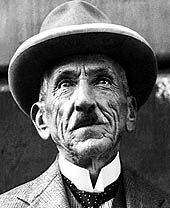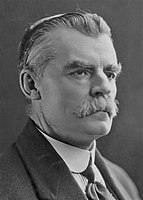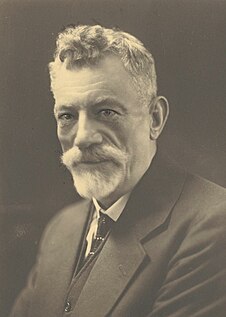
The Nationalist Party was an Australian political party. It was formed on 17 February 1917 from a merger between the conservative Commonwealth Liberal Party and the National Labor Party, the latter formed by Prime Minister Billy Hughes and his supporters after the 1916 Labor Party split over World War I conscription. The Nationalist Party was in government until electoral defeat in 1929. From that time it was the main opposition to the Labor Party until it merged with pro-Joseph Lyons Labor defectors to form the United Australia Party (UAP) in 1931. The UAP was the immediate predecessor to the current Liberal Party of Australia, the main centre-right party in Australia.

The Parliament of Australia is the legislative branch of the government of Australia. It consists of three elements: the Crown, the Senate and the House of Representatives. The combination of two elected chambers, in which the members of the Senate represent the states and territories while the members of the House represent electoral divisions according to population, is modelled on the United States Congress. Through both chambers, however, there is a fused executive, drawn from the Westminster system.

The Australian electoral system comprises the laws and processes used for the election of members of the Australian Parliament. The system presently has a number of distinctive features including compulsory enrolment, compulsory voting, majority-preferential instant-runoff voting in single-member seats to elect the lower house, the House of Representatives, and the use of the single transferable vote proportional representation system to elect the upper house, the Senate.

The 1998 Australian federal election was held to determine the members of the 39th Parliament of Australia. It was held on 3 October 1998. All 148 seats of the House of Representatives and 40 seats of the 76-seat Senate were up for election. The incumbent centre-right Liberal/National Coalition government led by Prime Minister John Howard of the Liberal Party and coalition partner Tim Fischer of the National Party defeated the centre-left Australian Labor Party opposition led by Opposition Leader Kim Beazley.
The Commonwealth Liberal Party was a political movement active in Australia from 1909 to 1917, shortly after Federation. The CLP came about as a result of a merger between the two non-Labor parties, the Protectionist Party and the Anti-Socialist Party which most of their MPs accepted. The CLP is the earliest direct ancestor of the current Liberal Party of Australia.

Federal elections were held in Australia on 24 March 1990. All 148 seats in the House of Representatives and 40 seats in the 76-member Senate were up for election. The incumbent Australian Labor Party led by Bob Hawke defeated the opposition Liberal Party of Australia led by Andrew Peacock with coalition partner the National Party of Australia led by Charles Blunt. The election saw the reelection of a Hawke government, the fourth successive term.

The politics of Australia take place within the framework of a federal parliamentary constitutional monarchy. Australians elect parliamentarians to the federal Parliament of Australia, a bicameral body which incorporates elements of the fused executive inherited from the Westminster system, and a strong federalist senate, adopted from the United States Congress. Australia largely operates as a two-party system in which voting is compulsory. The Economist Intelligence Unit has rated Australia as a "full democracy" in 2017.

Federal elections were held in Australia on 10 December 1949. All 121 seats in the House of Representatives and 42 of the 60 seats in the Senate were up for election. The incumbent Labor Party, led by Prime Minister Ben Chifley, was defeated by the opposition Liberal–Country coalition under Robert Menzies. Menzies became prime minister for a second time, his first term having ended in 1941.

Federal elections were held in Australia on 21 August 1943. All 74 seats in the House of Representatives and 19 of the 36 seats in the Senate were up for election. The incumbent Labor Party, led by Prime Minister John Curtin, defeated the opposition Country–UAP coalition under Arthur Fadden.

Federal elections were held in Australia on 12 October 1929. All 75 seats in the House of Representatives were up for election, but there was no Senate election. The election was caused by the defeat of the Bruce-Page Government in the House of Representatives over the Maritime Industries Bill, Bruce having declared that the vote on the bill would constitute a vote of confidence in his government.

Federal elections were held in Australia on 17 November 1928. All 75 seats in the House of Representatives and 19 of the 36 seats in the Senate were up for election. The incumbent Nationalist–Country coalition, led by Prime Minister Stanley Bruce, defeated the opposition Labor Party led by James Scullin.

Federal elections were held in Australia on 16 December 1922. All 75 seats in the House of Representatives, and 19 of the 36 seats in the Senate were up for election. The incumbent Nationalist Party, led by Prime Minister Billy Hughes lost its majority. However, the opposition Labor Party led by Matthew Charlton did not take office as the Nationalists sought a coalition with the fledgling Country Party led by Earle Page. The Country Party made Hughes's resignation the price for joining, and Hughes was replaced as Nationalist leader by Stanley Bruce.

Federal elections were held in Australia on 13 December 1919. All 75 seats in the House of Representatives, and 19 of the 36 seats in the Senate were up for election. The incumbent Nationalist Party, led by Prime Minister Billy Hughes, defeated the opposition Labor Party led by Frank Tudor.

Federal elections were held in Australia on 5 May 1917. All 75 seats in the House of Representatives and 18 of the 36 seats in the Senate were up for election. The incumbent Nationalist Party, led by Prime Minister Billy Hughes, defeated the opposition Labor Party led by Frank Tudor.
This article provides information on candidates who stood for the 1925 Australian federal election. The election was held on 14 November 1925.
This is a list of members of the Australian Senate from 1929 to 1932. Half of its members were elected at the 14 November 1925 election and had terms starting on 1 July 1926 and finishing on 30 June 1932; the other half were elected at the 17 November 1928 election and had terms starting on 1 July 1929 and finishing on 30 June 1935. The process for filling casual vacancies was complex. While senators were elected for a six year term, people appointed to a casual vacancy only held office until the earlier of the next election for the House of Representatives or the Senate.

A federal election to determine the members of the 44th Parliament of Australia took place on 7 September 2013. The centre-right Liberal/National Coalition opposition led by then-Opposition leader Tony Abbott of the Liberal Party of Australia and Coalition partner the National Party of Australia, led by Warren Truss, defeated the incumbent centre-left Labor Party government of Prime Minister Kevin Rudd by a 17-seat 3.6 percentage point two-party swing. Labor had been in government since the 2007 election. Abbott was sworn in by the Governor-General, Quentin Bryce as Australia's 28th Prime Minister on 18 September 2013 along with the Abbott Ministry and the members of the House of Representatives. The 44th Parliament of Australia opened on 12 November 2013, which is taken to be the commencement of the term of members of the House of Representatives. The new senators were sworn in by the next Governor-General Peter Cosgrove on 7 July 2014, with their six-year terms commencing on 1 July.
The history of the Australian Labor Party has its origins in the Labour parties founded in the 1890s in the Australian colonies prior to federation. Labor tradition ascribes the founding of Queensland Labour to a meeting of striking pastoral workers under a ghost gum tree in Barcaldine, Queensland in 1891. The Balmain, New South Wales branch of the party claims to be the oldest in Australia. Labour as a parliamentary party dates from 1891 in New South Wales and South Australia, 1893 in Queensland, and later in the other colonies.



















